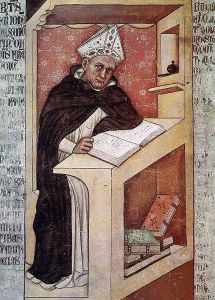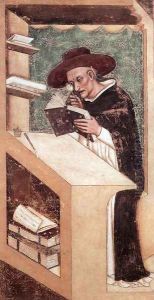Tommaso Da Modena Paintings
Tommaso da Modena, born Tommaso Barisini in 1326, was an Italian painter of the Gothic period, hailing from Modena in northern Italy. His contributions to the art of the 14th century mark him as a significant figure in the transition from medieval to Renaissance art, embodying the early stages of this pivotal shift in European art history. Despite the relatively few surviving works definitively attributed to him, his artistry is renowned for its detailed narrative scenes, expressive figures, and pioneering use of perspective.
Tommaso's early life is shrouded in mystery, with limited records on his upbringing or training. However, it is believed that he was part of a family of artists, which may have influenced his early exposure to painting and artistic forms. His career took a significant turn when he moved to Treviso, a city that became central to his artistic output. In Treviso, he received commissions that allowed his innovative style to flourish, notably at the Church of San Nicolò, where his fresco cycle depicting Dominican monks showcases his talent for individualized portraiture and intricate architectural perspectives.
Among Tommaso's most celebrated works is the series of frescoes in the chapter house of the Church of San Nicolò in Treviso, painted in 1352. These frescoes are considered groundbreaking for their lifelike representation of monks engaged in scholarly activities, a theme that anticipates the humanist interests of the Renaissance. His ability to capture the unique personalities and moods of his subjects, along with the detailed rendering of interiors, positioned him as a forerunner in the development of realistic portraiture and spatial illusionism.
Beyond Treviso, Tommaso's work spread to other Italian cities, including his native Modena and Bologna, where his contributions to church frescoes further cemented his reputation. Despite the scarcity of surviving works, his influence persisted, inspiring future generations of artists in the Veneto region and beyond. Tommaso da Modena's legacy is that of an innovator who bridged the medieval traditions with the emerging Renaissance aesthetics, leaving an indelible mark on the trajectory of Italian art.
Tommaso da Modena's death in 1379 marked the end of a career that had significantly impacted the development of Italian painting. His work, characterized by a delicate attention to detail and an early mastery of perspective, reflected the changing tastes and philosophical interests of his time, heralding the broader shifts that would fully blossom in the Renaissance. Despite the challenges of attributing many works to him with certainty due to the common practice of not signing art during his era, the pieces firmly attributed to Tommaso showcase a remarkable blend of innovation and tradition, securing his place in the annals of art history.

